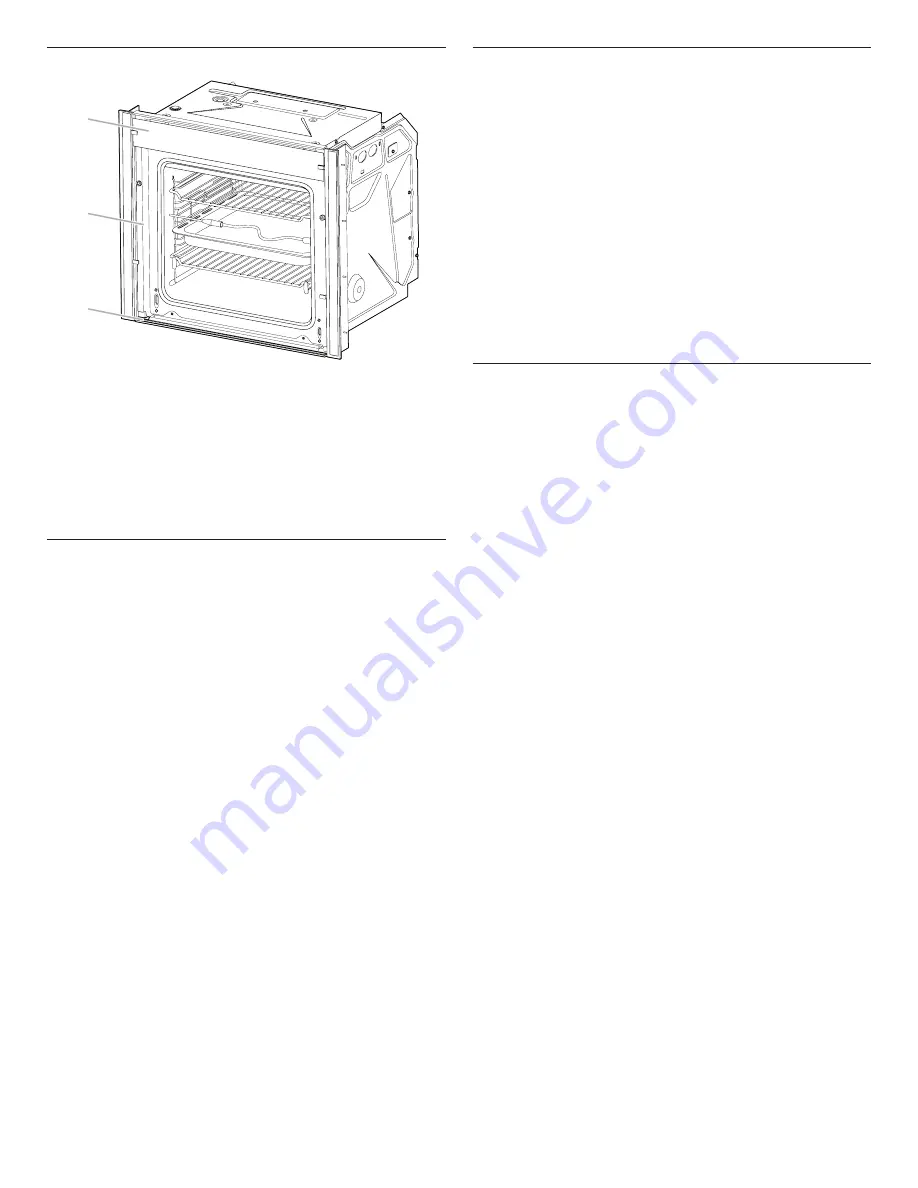
10
Oven Vent(s)
The oven vent(s) should not be blocked or covered since they
allow the inlet of fresh air into the cooling system. Also, the
bottom vent should not be blocked or covered since it allows the
inlet of fresh air into the cooling system and the outlet of hot air
from the cooling system. Blocking or covering vents will cause
poor air circulation, affecting cooking, cleaning, and cooling
results.
Preheating and Oven Temperature
Preheating
When beginning a Bake cycle, the oven will begin preheating
after Start is pressed. The oven will take approximately 6 minutes
to reach 350°F (177°C) with all of the oven racks provided with
your oven inside the oven cavity. Higher temperatures will take
longer to preheat. The preheat cycle rapidly increases the oven
temperature. The actual oven temperature will go above your
set temperature to offset the heat lost when your oven door is
opened to insert food. This ensures that when you place your
food in the oven, the oven, will begin at the proper temperature.
Insert your food when the preheat tone sounds. Do not open the
door during preheat before the tone sounds.
Rapid Preheat
Rapid Preheat can be used to shorten the preheating time. Only
one standard flat oven rack should be in the oven during Rapid
Preheat. Extra racks should be removed prior to starting. The
preheating cycle should be completed before placing food in the
oven. When the Rapid Preheat cycle is complete, the oven starts
a normal Bake cycle.
IMPORTANT:
Rapid Preheat should be used only for one-rack
baking.
Oven Temperature
While in use, the oven elements will cycle on and off as needed
to maintain a consistent temperature, but they may run slightly
hot or cool at any point in time due to this cycling. Opening the
oven door while in use will release the hot air and cool the oven
which could impact the cooking time and performance. It is
recommended to use the oven light to monitor cooking progress.
Before baking and roasting, position racks according to the
“Positioning Racks and Bakeware” section. When roasting, it is
not necessary to wait for the oven preheat cycle to end before
putting food in unless it is recommended in the recipe.
Baking and Roasting
The oven will take approximately 6 minutes to reach
350°F (177°C) with all oven racks inside the oven cavity. The
preheat cycle rapidly increases the temperature inside the
oven cavity. Higher temperatures will take longer to preheat.
Factors that impact preheat times include room temperature,
oven temperature, and the number of racks. Unused oven racks
can be removed prior to preheating your oven to help reduce
preheat time. The actual oven temperature will go above the set
temperature to offset the heat lost when the oven door is opened
to insert food. This ensures that the oven will begin at the proper
temperature when you place food in the oven. Insert food when
the preheat tone sounds. Do not open the door during preheat
until the tone sounds.
During baking or roasting, the bake and broil elements will cycle
on and off in intervals to maintain the oven temperature.
Depending on the model, if the oven door is opened during
baking or roasting, the heating elements (bake and broil) will turn
off approximately 30 seconds after the door is opened. They will
turn on again approximately 30 seconds after the door is closed.
Broiling
When broiling, no preheating is necessary unless recommended
otherwise in the recipe. Position food on grid above the drip tray,
and then place it in the center of the oven rack. Close the oven
door to ensure proper broiling temperature.
NOTE:
Odors and smoke are normal the first few times the oven
is used or if the oven is heavily soiled.
Changing the temperature when broiling allows more precise
control when cooking. The lower the broil setting, the slower the
cooking. Thicker cuts and unevenly shaped pieces of meat, fish
and poultry may cook better at lower broil settings. Refer to the
“Positioning Racks and Bakeware” section for more information.
On lower settings, the broil element will cycle on and off to
maintain the proper temperature.
A
B
C
A. Control panel
B. Oven
C. Oven vent
Summary of Contents for JJW6024HL
Page 27: ...27 Notes...











































